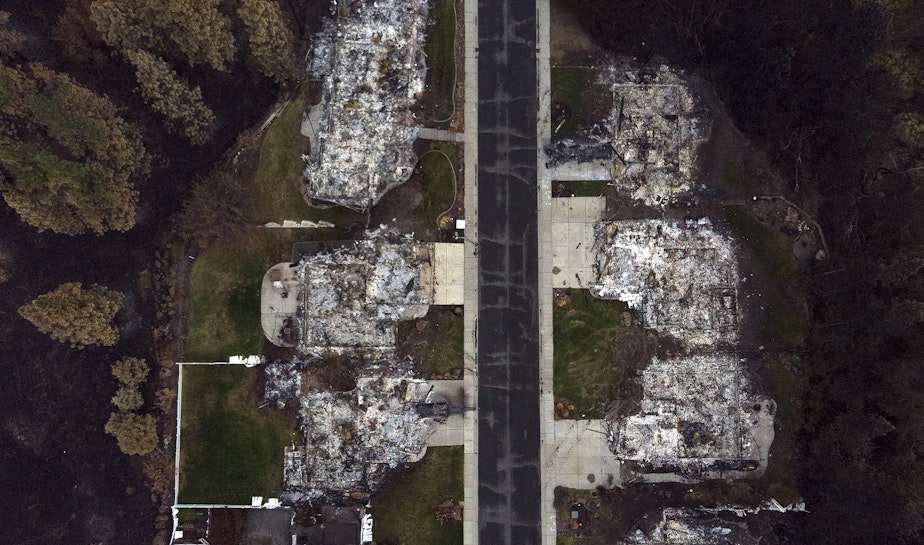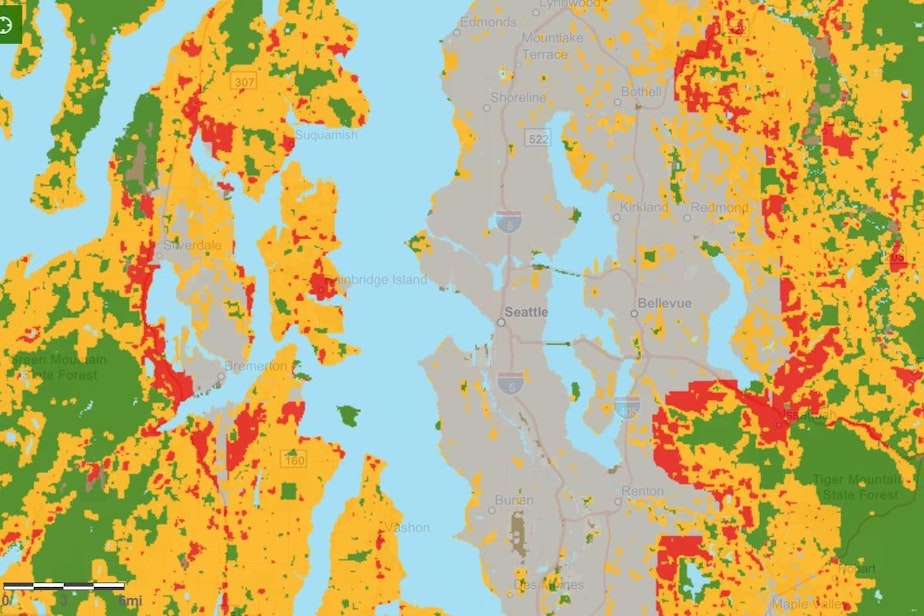Tree lovers, building officials clash over greenery in Washington wildfire zones

When the Gray fire tore through the Spokane County town of Medical Lake in August, one house just outside town limits was spared, even as the homes on either side burned to the ground.
City of Spokane Fire Marshal Lance Dahl said the house was saved with no help from firefighters.
“It was all prep work done by the homeowner,” Dahl said.
The homeowners had removed highly flammable juniper and arborvitae shrubs from their yard and, within 18 inches of their home, replaced flowerbeds with gravel. They’d also installed leaf guards on their gutters and kept lawns mowed down to 4 inches. As the Gray fire spread across their yard, its flames stayed less than 8 inches high, according to Dahl, and left their house unscathed.
The homeowners hadn’t taken the same measures around their detached garage.
“So they ended up losing the structure that they didn't harden and help protect, but they saved their main house,” Dahl said.
Sponsored
Under state rules that take hold in March, measures to create fire-resistant spaces around new or newly renovated buildings will be required on more than 5 million acres, or 12% of all land in Washington.
Tree advocates say the impending building-code rules are unnecessarily sweeping and, by forcing property owners to remove shade-giving trees to create “defensible space” around homes, will worsen the climate change that is making fires burn hotter and more often.
“The huge amount of carbon released by this much tree clearing will further heat the planet, which we know then leads to more forest fires,” Lynn Fitz-Hugh with the Olympia-based nonprofit Restoring Earth Connection told the Washington State Building Code Council, the agency that sets statewide building standards, in September.
“I think there's some misinformation,” Building Code Councilmember Micah Chappell told KUOW. “They think that ‘defensible space’ means you cut down or remove all trees and vegetation, and that's not the case at all.”
Under the impending rules, trees around new or remodeled buildings adjacent to wildlands would have to be spaced at least 10 feet apart, with branches cleared up to 6 feet off the ground.
Sponsored
Anywhere from 30 to 100 feet around a building would have to have its vegetation thinned, depending on a 12-point hazard assessment that incorporates construction materials, topography, road access, and water availability for firefighters.
Buildings would also have to use fire-resistant materials.
The rules were enacted by the Washington state Legislature in 2018, contingent on the Washington Department of Natural Resources completing a map of the neighborhoods around the state where the rules would apply. Those areas, where buildings and fire-dependent ecosystems bump up against each other, are known as the wildland-urban interface or WUI (pronounced “wooey”). The Department of Natural Resources completed its wildland-urban interface map, shown below, in 2021.
It highlights the areas most at risk of destruction by wildfires, where development sits next to land mostly covered in burnable vegetation (the “interface,” in red) or sits between two tracts of burnable vegetation (“intermix,” in gold).
With development spreading continuously into the state’s forests and grasslands, the Department of Natural Resources calls the wildland-urban interface “Washington’s fastest-growing environment.”
Sponsored
Washington Department of Natural Resources' interactive map of the state's "wildland-urban interface," produced in 2021.
Washington state’s building code sets minimum standards for how residential and commercial structures should be designed and built. The state code, covering a variety of concerns from earthquake safety to energy use, is mostly derived from an international building code developed by building-safety professionals.
Chappell said the state’s “defensible space” landscaping requirements were simply adopted from the international code, where they have been in place for years.
“We didn't modify the base code language, and vegetation is allowed,” Chappell said. “It's just modifying of fuels.”
Environmental advocates say the required tree thinning is far broader than necessary for wildfire resilience, especially in Western Washington, and goes against other government efforts to expand tree cover for the various benefits trees provide.
Sponsored
King County’s 30-year forest plan, for example, aims to “maintain and increase existing tree canopy in urban areas, prioritizing areas with low canopy cover.” Lower-income areas such as White Center have less than half the tree canopy of leafier, wealthier areas including Bothell and Normandy Park and suffer higher temperatures during heat waves as a result.
“In this new climate era, trees are needed more than ever for carbon capture, flood reduction, cooling effects, pollution reduction, and many other benefits,” Michael Feerer with the Bellingham-based Whatcom Million Trees Project told the Building Code Council in September.
Feerer said fire-resistant building materials and features, like leaf guards on gutters, work much better than reducing vegetation a stone’s throw away.
“The key igniter of a home is flying hot ashes, and those can travel for miles in a wildfire event," Feerer said. "It's not nearby trees.”
Dahl, the Spokane fire marshal, said distant embers and nearby vegetation both pose hazards.
Sponsored
“Ember showers are horrific, especially in a large, wind-driven event,” Dahl said.
Department of Natural Resources officials told KUOW they were unable to provide estimates of how many acres, buildings, or residents are found within the wildfire-urban interface zones the agency has mapped.
Geographic information system analyst Katie Sauter-Messick of Seattle analyzed the state’s wildland-urban interface map for KUOW and found that 12% of Washington lies within the wildland interface and intermix categories.
In King County alone, at least 131,000 buildings sit within the wildland-adjacent zones.
Owners of existing buildings next to wildlands are not required to alter their landscaping under the building code unless they replace their roofs or do other major remodels.
A close look at the Department of Natural Resources map reveals that it’s not just sprawling developments at the suburban fringe that make up the wildland-urban interface. Many areas next to Seattle city parks, many shorelines, and most of the major islands of Puget Sound also fall within the map’s gold and red zones.

In 2020, the U.S. Forest Service designated almost all of Western Washington as having low or very low wildfire hazard potential. Wildfires are much less frequent on the wetter, western side of the state, though scientists warn that frequency is likely to increase as heat-trapping pollution continues to alter the global climate.
“In the environment we're in now, and the higher temperatures we're seeing, I'm getting calls all the time from fire marshals on the west side of the state that really haven't had to deal with wildland-urban interface fires before, and they're starting to appear,” Dahl said.
State Building Code Council officials said, despite public comments from environmental advocates at the council’s September meeting, the council has not received specific proposals for modifying the state’s wildland-adjacent building requirements.
“Those folks can propose changes to this. We encourage it,” Chappell said.
The state’s building code gets updated on a three-year cycle. Chappell said any new proposals adopted by the council would become effective in 2026.




